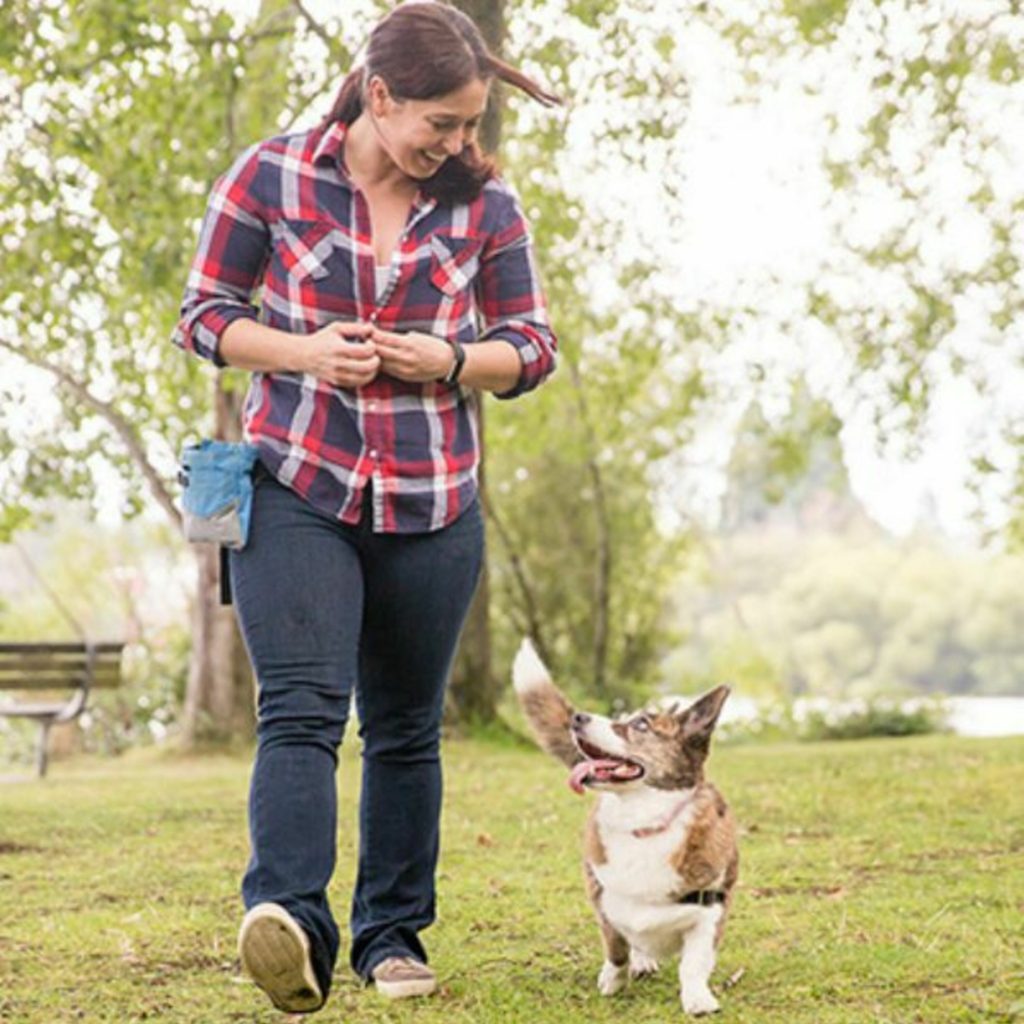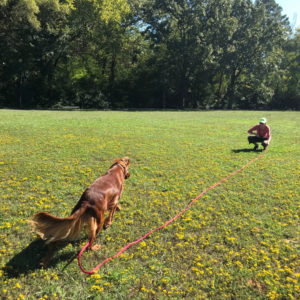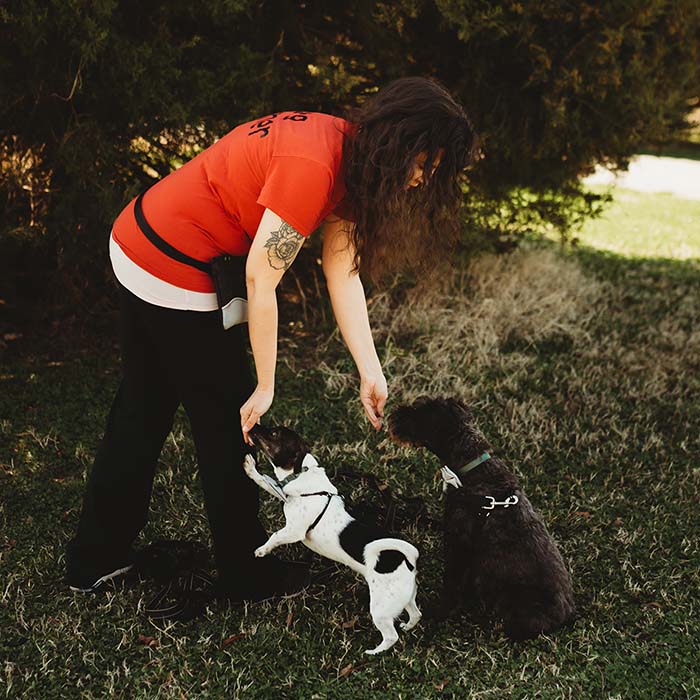“What Are My Options?”: Responsible Rehoming with Cathy Madson
Podcast Transcript
[Intro]
Cathy: And so when they mismatch, they really need to be better about just being like, “It was a mismatch,” then just starting over. “Now, we know more information.” Because that family that I worked with, they did go back to the shelter and the shelter made them feel like crap. So they’re like, “One, I’m never adopting from a shelter again,” and two, they gave the dog away to friends or family or something. And I’m like, you know, it’s not the best way. And then they just ruined someone’s whole opinion about rescue dogs.
[Music]
Elizabeth: Hi, welcome back to Telltail Dog the podcast. I’m your host, certified dog trainer Elizabeth Silverstein, and I have with me again—welcome back—is Cathy Madson, a certified dog trainer and behavior consultant who’s on staff at Preventive Vet. Cathy focuses on helping humans and their pets build a strong relationship built on trust, clear communication, and the use of positive reinforcement training methods. Specialties include canine separation anxiety, leash reactivity and dog aggression. Hi Cathy, how are you?
Cathy: I’m great. How are you?
Elizabeth: I’m doing alright. I’m so excited to have you back. Thanks for being willing to do this again.
Cathy: Of course. I’m excited.
Elizabeth: Well, the reason I wanted to have you back is there’s been a lot of conversations in my area recently, and as I was talking to you about that, you mentioned that this has come up for you as well. So the focus of today is we’re going to be talking about re-homing. And I’m going to link to the article that you wrote about that. How did you come up with the idea to write this article on Preventive Vet?
Preventive Vet Rehoming Article
Cathy: Well, it’s something that comes up in certain kinds of cases that I work. I work a lot of aggression cases, and so it’s always something that is sitting in the back of my mind, but also, I found, in the back of clients’ minds, where they start to wonder, “What are my options?” And with any dog behavior issue, you have really five options. You can do nothing and just let it be, or you can manage it. So you manage it as much as possible so it doesn’t rehearse, and then you can do behavior modification. It’s fantastic. You combine that with management, right? Then you have rehoming. Rehoming is an option for behavior issues. And then the fifth option is behavioral euthanasia. And those number four and five options, people don’t want to really talk about because there’s a lot of emotional responses involved with that and feelings of guilt and failure, but it’s something to really consider in certain cases. Not for every case. But they’re one of the five options that we have for behavior issues. So I wanted to really make sure that people understood why it happens. Why people might need to re-home their dogs, for reasons outside of behavior issues, and then what to do if they need to. Because there’s actually a lot more resources out there than I think people know about if they need to find a new home for their dog.
Five Options When You Have an Issue:
1. Do nothing.
2. Manage the behavior.
3. Incorporate a behavior modification plan.
4. Rehome.
5. Consider behavioral euthanasia.
Elizabeth: Absolutely. And one thing I’m working on is really removing the stigma of having those conversations, because there is a lot of stigma. There’s a lot of shame. And I think there’s a lot of either organizations or individual people in our industry that really pile on that guilt and that shame and people feel like they’re failures. And I have not found that with my clients. I’ve had maybe five or six rehome the past two or three years and it’s never an instant decision in my experience. It’s after six months of really trying to work through it. Or I had one client recently that it was three years before they just realized this just wasn’t working and it’s not safe situation for anybody. This dog needs a lot more than what we can provide.
Cathy: Yeah. Yeah. And I think you’re right. It’s not always a split-second decision for people. It is a heartbreaking decision. And they feel awful. And it’s also something that, the majority of times I’ve had to talk to people about it, it’s not the first thing that we decide. “Oh, you just need to re-home your dog.” That’s not how it works. And I think some people assume that that’s it, but in my experience, it never has been that. And I think we’re lucky as trainers, as professionals, where they’re trying. The fact that they contacted us to begin with, shows that they’re trying. They’re trying to find out what to do, how to fix these things. In my work as an adoptions counselor and dog trainer at a shelter, way back when I was a baby trainer, that’s where I got to see a little bit more of that frustrating, “You’re not even trying to find ways to not give up your dog.” That’s what I think is hard and I think that that’s what really frustrates some people, because that’s all they see. So I think it depends on where you’re situated and what you see, that determines your judgment of when you see it happen again, if that makes sense.
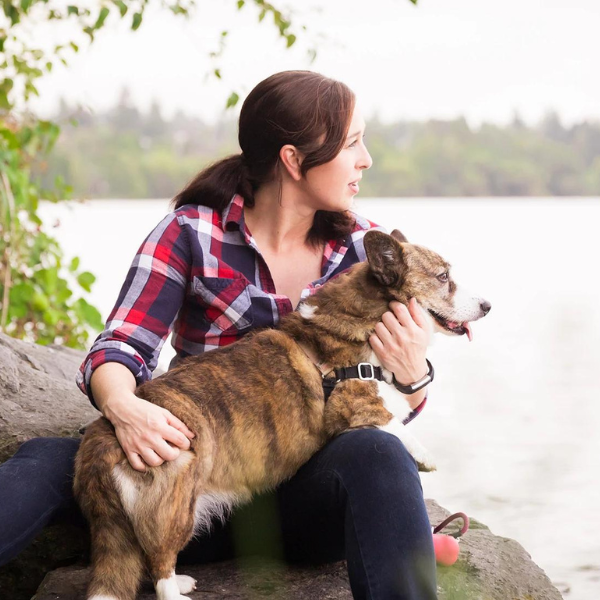
Elizabeth: It absolutely does and I think you’re absolutely correct. Because when you’re in rescue or you work at a shelter, you’re seeing a massive amount of people and maybe you don’t get the whole story or maybe they’re very clear about it, but I think you’re gonna see more of people just like, “I don’t want to deal with this, goodbye.” And that’s not what I see as a trainer, but that doesn’t mean that that’s not what happens either or can happen sometimes. But I do think it makes it harder because if you are a rescue or a shelter and you’re seeing that a lot, if you come hard [on]—and I’ve seen this recently at a from a local rescue—the only reason to rehome is if you die. That’s not helpful either for anybody.
Cathy: Well and what that tends to do is it drives people away from rehoming responsibly and that’s not what we want, either. One, we want to give people resources to try to keep the dog in the home and there’s some reasons for rehoming that there are ways. If it’s financial struggles or the human is facing a medical issue and needs to go into the hospital long-term or long-term care, there are ways to find long-term fosters, things like that that they might just not know about. But if they really have a good reason for rehoming their dog, sometimes they won’t even be honest when they’re doing intakes into the shelter. Or if they feel like they’re going to be judged and shamed even more, that’s when you get people who feel like they have no other option than to just abandon their dog somewhere and we don’t want that. We want to be able to find that dog a new home that’s going to be a place they can thrive. We want to set that dog up for success and the first way we do that is making sure that we can get as much history as we can. And then having some compassion for those people. In most of these cases, they’re heartbroken that they have to give up their pet. So, some compassion and grace for them, I think, is really where we start and then that helps us find that dog a better home.
Elizabeth: Absolutely. There’s a photo circulating right now on social media. This little tan dog tied up to a fire hydrant with all their stuff packed up next to them, and you could tell just how this was done, this person cared deeply for their dog and maybe that was the only thing they could think of to do. Maybe there was shame. Maybe someone else did it. But if we can have more compassion in those situations, get that history, get that information–does this dog like peanut butter or yogurt, little things like that can really help ease the transition into a new home as well and can really help people. For someone, they can’t handle separation anxiety, like they don’t have to set up for it–as a dog trainer, that’s really tough for me–but there are families out there or people out there that can absolutely handle separation anxiety and have the resources to do it. So if we knew that about the dog and then we can be honest about the issues and the care and what they need, it can be so much easier to find the right fit for them.
Cathy: Yeah, and a lot of behavioral issues that make rehoming an option to consider, a lot of it depends on the management that people are able to do and sometimes the management is impossible. You can’t ask someone to choose between their job and treating their dog’s separation anxiety because how are they going to pay for that dog’s care if they’re not working? And some people are lucky enough to work from home or have multiple people in the home so that the dog isn’t left alone while they’re working on behavior modification things. So, it really is, you’re right, about finding out that information. The small things. Oh, this dog does not like cats right, so let’s not adopt this dog to a home with cats. So that’s where I think we need to start. Having that compassion so that we can get that information so then we can help that dog even more and then you get better quality of life for not only the dog but also the people. And that’s important. People should have good quality of life, just like dogs should.
Elizabeth: Yeah. And there’s ways to match. So as you know, I just adopted a Belgian Malinois. I thought she had separation anxiety. It was so stressful because I don’t have help. If she’s gonna hurt herself or destroy my home and I can’t work, then I lose my home. And that’s serious. That’s serious enough to consider maybe it’s not a good fit. But even when I was kind of processing that and trying to figure her out because I had no history on her, either, it was thinking about returning her. What did that look like, there was a lot of shame and concern around that even for myself, who knows it’s not a shameful—
Cathy: But sometimes I feel like as professionals, it’s almost worse because we’re like, everyone’s gonna think that we should have known what to do but sometimes knowing what to do, we know, this isn’t the right match. I don’t have the resources I need to help this dog and it’s just going to spiral and get worse and worse and worse. But there’s a lot of guilt I think for professionals when we’re like well, we failed and that’s worse, because I’m supposed to know what to do.
Elizabeth: It is. It truly is and there are some high-level names in the dog industry that I bring up all the time who’ve had to rehome. Like, Dr. Patricia McConnell is a big one. She has a beautiful farm. I think she’s in Wisconsin. She has border collies [and] she ended up with this one border collie. He was not happy with her. He did not want to be on her farm and so she’s like, I got to rehome him. He doesn’t want to be here. So if someone with 20 plus years of experience with an advanced doctorate degree has to re-home what makes anyone to say, like a dog owner has no right to consider that if they need to.
Cathy: Yeah and I think it’s important too, again, we’re talking more about those cases that people are doing. They’re trying. They’re doing things to try to fix it and then they get to this point. And I think it is important to always differentiate that there are really crappy people out there.
Elizabeth: Yes.
Cathy: But I don’t think that they’re the majority. I think that we need to give people the benefit of the doubt, too, but there are people out there who are just like, “I don’t want to deal with this and I don’t even want to try so I’m just going to drop this dog off. Tie it to the outside of a shelter.” I saw that happen in the middle of the night, which is illegal. Abandoning a dog is illegal. Or they just drop them off in the middle of nowhere in the boonies. Let them go and survive on your own, I guess. So that isn’t responsible rehoming. But I think that a lot of people are looking for: “How do I re-home a dog responsibly?” And that’s, one, I think shelters need to make it easier for people and I also think that trainers and behavior consultants, we need to support those people and get familiar with what resources there are. When I was researching for the article, I was like, wow I had no idea there was all this stuff out there, as far as food banks. they provide pet food, a lot of them, or there’s national organizations that help you connect with long-term fosters. So, for military members who are deploying, who can’t take their dog with them for obvious reasons, there are organizations that help you find someone to care for your dog while you’re away. Or for people who are going to the hospital for treatment and can’t bring their dog or they don’t have the energy to care for their dog while they’re going through treatment, there are ways to connect with people who volunteer as fosters and things like that. And I had no idea that there was that much out there.
Elizabeth: And it includes transport too, so if you feel like there’s nothing in your state, there’s a lot of ways to get transport, volunteers to transport your dog, even if your dog goes a couple states away for however long you need, that’s still a better option than having to give your dog up completely. Another thing is financial. You and I, we see the people that are trying. We also see the people that either have the resources or they find a way to have the financial resources and just because someone doesn’t have money, doesn’t mean that they should have to give up their dog, either.
Cathy: Exactly, yeah. And that’s a big thing at Preventive Vet. We really feel like money shouldn’t be a block to sharing your life with a pet. And owning a dog is expensive.
Elizabeth: So expensive.
Cathy: I mean, I just took my dog to the vet this week for something he ate and thank god for pet insurance, but pet insurance isn’t cheap and so, one, I think there are resources out there. It’s just knowing how to find them and then not feeling embarrassed that you need help caring for a dog. It is expensive, right, so finding those resources is important. And then just being neighborly. And helping your neighbor out, is really good. Because if we can keep dogs in homes rather than send them through the rehoming process, which sometimes involves staying in a shelter, which is stressful. There’s ways to keep that dog in the home. If it’s appropriate, we should try that first but then if that doesn’t work if there’s other reasons. So we talked about financial reasons. There’s the health issues and sometimes those health issues are the dogs themselves because treatment can be very expensive, so in some cases, people will surrender their dog to a shelter, who is then able to provide the medical care, right. But then you look at what resources do they have? A lot of veterinary schools have some programs where you can get subsidized care for your pet, but then also rescues, non-profit organizations, sometimes they’re more likely to provide that care at reduced cost if you just go to them and ask and tell them what’s going on because they’d rather keep that dog in the home than bring it into their shelter and then adopt it out again.
Elizabeth: Especially right now. Numbers are high across, I think, the United States. Shelters and rescues are stuffed to the brim.
Cathy: Yeah. Yeah, and not all of them have that kind of medical, veterinary resources, but, you know, they network. I know here in the Seattle area, there’s a few different rescues that specialize. They’re kind of known as they have the veterinary care and then other ones specialize in foster and care for the old dogs. So it just kind of depends. You have to find that niche. You have to find the right resource. But beyond the medical issues, sometimes you just see the behavior issues. Those are the ones that I think you and I see the most, where separation anxiety is a big one, but then you also have aggression. And those are the cases that I’ll bring up rehoming as an option to consider sooner. It’s not the cases where okay, the dog is pulling on leash. No one really rehomes their dog for that, as far as I know. It’s more of those intense behavioral problems and that’s where people or other pets are in danger and that’s where I’m always like, we have to at least talk about it because it is something you can consider if management and behavior modification isn’t enough, or if the management and behavior modification is too much for you to do. And it can happen. Because sometimes, I mean you know, this with separation anxiety, oh my goodness, treatment can take a long time. So it depends on what can people do and then how much in danger in aggression cases are they or other family members or pets in the home and what do we do.
Elizabeth: Yep because there’s different levels to that, too, as you know, right, you’ve mentioned to me before, owner-directed aggression is a different thing than if there’s small children in the home or it’s much more manageable to manage a dog that won’t let people come in the home than it is for that dog to be attacking people in the home that belong there. So there’s just so many different ways and things that can happen and sometimes management is super easy in a situation and sometimes it’s not.
Cathy: Sometimes it’s not, yeah. Sometimes too, if for regression cases, if the trigger for aggression is unpredictable, that’s really hard to manage. Because you just don’t know. Okay, are they having a bad day today? What is it that’s going to trigger it today, and it’s hard to then control the environment and the antecedents and all these things around it to prevent it, if it’s unpredictable. If you don’t know. And also with homes with children, I am pretty solid on the I am going to put your child safety first and you should too. I know most people do but I think it is hard because you’re like, well I love my dog, too, and I’m like, I get it, but your young child is in danger in this situation, etc., etc. So it is looking at that and again it depends on the age of the children. Depends on the aggression trigger and things like that, so there’s a lot of factors that have to be looked at before really deciding like, “Hey this is an option we need to look at and start to pursue” versus just “This is potentially something that could happen in the future.” It’s really hard.
Elizabeth: It is. It is. but I think it’s just it’s so important to just start the process of destigmatization especially for people that are–the majority of people that are doing everything that they can and maybe they need some help and to remember too, as trainers, yeah, we need money to live and we need to get paid for our work, but there’s also resources out there. Like, there’s Every Dog Austin that offers discounted or free training to folks. There’s a lot of wonderful nonprofits across the United States that have great workshops for free. And there’s also so many wonderful courses that are a lot cheaper than hiring a trainer, like Play Way by Dr. Amy Cook that’s all about—
Cathy: I love that one.
Elizabeth: It’s the play is magic. That just makes me just like, ah.
Cathy: Yeah and what I offer is some of my clients, they’ll purchase say like a package of training, but then they don’t use it all and so then they have the option of keeping it on the books for them later for whatever questions they might have, but also I see a lot of my clients go, “I’m just gonna donate it to someone who needs it”, and so I have a bank saved up of that training opportunity for other people to draw from. So you can always reach out to trainers and ask right like, “Hey, I can’t afford your full behavior consult but are there any options? Can you help me? Point me in the right direction at least or do you have a program like that where people have donated some of those training hours to cover your time?” So there’s options out there, for sure.
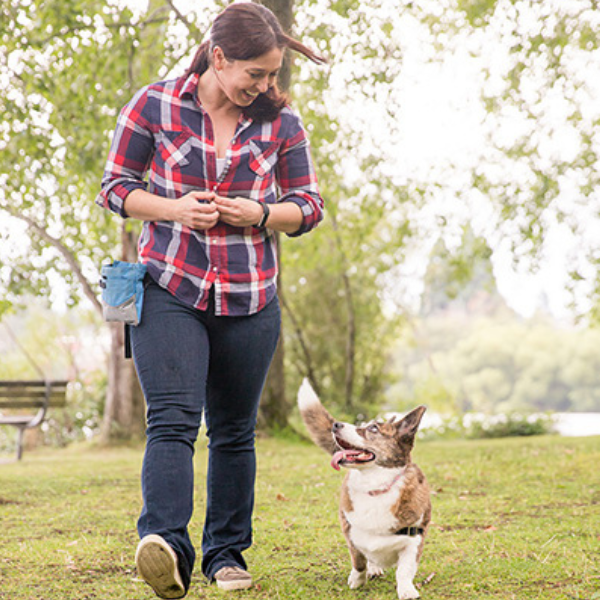
Elizabeth: Yeah. I think sometimes our own shame prevents us from just asking questions and even if it’s a no or you get ignored, you tried so there’s no shame. It’s something that’s important to remember when it comes to shame and embarrassment, it’s not on you if someone tries to pile on those feelings. That’s a them problem not a you problem. Tshere’s no shame or embarrassment in trying or reaching out. How that person reacts to you reaching out says more about them than it does about you just trying.
Cathy: Right. Totally right. Yeah, I think what’s hard though is it can feel discouraging when you’re like, “Wow, another one just told me that well, I’m just not doing enough.”
Elizabeth: Yes. Yes.
Cathy: That can really rail on someone.
Elizabeth: Yes, that is absolutely true, but then you just have to think about the averages, so—
Cathy: Exactly.
Elizabeth: Try 50 times. Just make it a goal. Try 50 times. Maybe you get 50 no’s, maybe you get five resources and maybe one yes. And all you need is one yes. Or one person saying, “Yeah I can help you or I can point you in the right direction.” But it is hard. It’s a rough one.
Cathy: No one likes it.
Elizabeth: No, I do not. I’d rather not try than be rejected. But that’s something I just work on. So, Cathy, I wanted to talk to you a little bit about that responsible rehoming aspect and touch on that. So what I’ve told clients, and I’d love your input on this, I’m like, if you reach to some rescues to reach out to, can you foster your dog for a certain amount of time while they look for a home? So that’s what I tend to recommend because then, you have an end time in sight. It’s not forever. Maybe it’s three months to six months while they look and then they don’t have to find a foster because if a rescue’s full, it’s hard for them to take a dog. So I do look at it that way.
Cathy: So, there’s a couple things I look at first. What I recommend clients do if they’re like, “I think rehoming is the best option and that’s what we’re going to do,” then I’m like, “Okay, well, first, what we want to do is write out like an info sheet on the dog.” And I want my clients to be as honest as possible. And again, I’m working mostly with clients who are re-homing because of behavioral issues, and this step is important because I need—whether it’s the shelter or rescue or the new foster home or the new adopter if they’re doing home-to-home adoption—I need them to know about this behavior so that they’re set up for success. And so that kind of info sheet that they create, it kind of becomes a sales pitch a little bit because I’m like, include all the great things about your dog, but then be honest about, one, why you’re re-homing and then two, this is what this dog needs to be successful and to thrive in their new home. And having that info sheet, one, it gives you something to give to family and friends so that they can kind of spread the word and help. You can give it to your veterinary clinic and if they’re willing to post it or just keep it in mind because they might know someone in their network of clients as far as who might be looking for another dog who might be good match for that dog and they should be kind of familiar with your dog as well if they’ve examined it. So having that info sheet to start already gives you something to share easily.
If a dog came from a breeder, now if it was a responsible breeder, those breeders are very intent on not allowing their dogs to end up in shelters and rescues. I work closely in the cardigan corgi community and breeders run a breed-specific rescue for cardigan corgis and they are looking across the country at listings all of the time to pull those dogs from shelters and then find a home with cardigan experienced people.
Elizabeth: Because this is a high-level needs dog, right? This is a dog that has some, kind of like schnauzers, tend to tend to have—like you tend to look for people with experience because—
Cathy: Yeah, there’s some breeds that need a little bit more experience than others. It’s not always true for every dog, but, one, they’re looking for who is familiar with what cardigans need. There are some medical issues that cardigans are more prone to as they age. Back issues, thanks to the long-backed dogs, but they’re just familiar and that’s their passion and they don’t want the backlash that they get as breeders to be like, “Oh, well, your dogs just end up in shelters.” There was a survey—Gosh, I can’t remember the name of the survey, but I remember reading it. I’ll find it and send it to you so you can post it, but it shows that the majority of purebred dogs and shelters is actually very low outside of chihuahuas. I was like, okay, but then you’re looking at what breeds are bred primarily by responsible breeders. Like, cardigan corgis aren’t bred by backyard breeders really because they’re more rare, right. So you have to look at what’s the population of the dog breeds and all that. So, it’s interesting to see those stats because there are breeders out there who do care about what happens to their dogs. So if you got a dog from a responsible breeder, if you need to re-home them for whatever reason, they should be your first contact and they are typically more than helpful. A lot of them will take the dog back themselves or they will reach out and find someone who can take the dog for you that they trust. So that’s always the first part of contact. Now, if it’s a not-so-responsible breeder then you’re in the same boat as everyone else. Because usually they aren’t gonna take the dog back. Even if they did, they might not know what to do with that behavior issue, and so again, you don’t know if the dog’s gonna just continue to practice those unwanted behaviors or be really stressed out and things like that. So that’s a little harder when you do it. But if you got a dog from a breeder, you always want to contact them first see what the options are. Then, I look at if you have a purebred dog or even a mixed breed that’s, say, half—I’m just using corgis right now—like, half guardian and corgi, the Cardigan Rescue Network would most likely still take that dog or help you find a home for them because they care. So you want to look for a breed specific rescue. So if you have a half Doberman, contact a Doberman rescue, because they might have some good resources for you even if your dog’s not purebred, it doesn’t matter. They want to save dogs, too. So, reach out to those breeds specific rescues if you can.
Elizabeth: Yeah, breed specific rescues. If you want a Labrador, you can get a puppy Labrador from a rescue.
Cathy: Well, sometimes, too, people are like, “Oh, I want a lab, but I don’t want a puppy,” and they’re like, “But I don’t want to go to the shelter, because I don’t know those dogs.” And I’m like, “Call a breeder.” Because there’s a lot of adult dogs. That’s how I got Sookie. She was a year and a half when I got her from the breeder because she just stopped growing, so she didn’t want to show her anymore.
Elizabeth: Oh.
Cathy: So she was like, “Perfect. Pet home. Love it.”
Elizabeth: Yes. And the responsible breeders get dogs back all the time if it’s not a good fit.
Cathy: That’s the thing, too. If they match. Matching is so important. And there’s a story in my article where the shelter adopted out a puppy, so not a lot of history, like no big issues other than being a puppy, to a home whose young son was terrified of dogs. And because it’s a puppy, it’s jumping and it’s nipping and it is just scaring the crap out of this kid. And that was one where it was a much sooner conversation about, “You should take this dog back to the shelter because you don’t have the time. You both work full time and you’re raising two young kids. Your child is terrified of a puppy. I totally understand because it’s just all in its face.” So matching breeders, responsible breeders, are really trying to match really well. And so, they require—I know my breeder, getting Fozzy, she was like, “Okay, I’ve known you for 10 years now, but tell me what is your home like now? What do you want to do with this dog?” And so, she’s trying to match temperaments and things like that to the right home. But shelters, they try to do this, and it’s really hard. And so when they mismatch, they really need to be better about just being like, “It was a mismatch,” then just starting over. “Now, we know more information.” Because that family that I worked with, they did go back to the shelter and the shelter made them feel like crap. So they’re like, “One, I’m never adopting from a shelter again,” and two, they gave the dog away to friends or family or something. And I’m like, you know, it’s not the best way. And then they just ruined someone’s whole opinion about rescue dogs. Which has nothing to do with the dog.
Sometimes if people are considering re-homing, I tell them, “Board your dog for a couple of days to see what does your life feel like?” Like yes, it’s gonna be really depressing because you’re like, “I miss my dog,” but beyond that, especially for aggression cases, is your life better? Do you feel safer, and all of those things? Because sometimes that shows them, “Wow, I have been just changing my entire life around this problem and trying to manage it and missing out on so much.” That sometimes I think they don’t realize how much they’re limiting their world to care for a dog, so sometimes I tell them, “Board the dog for a couple of days. See how you feel, you know, and then go from there.” So it can help inform that whole process. So they know what it would be like and all of that and then like I mentioned spread the word through your veterinarian, your family, your friends. Having that little info sheet with some cute pictures on it. Really nice, right, but again you want to be really honest in that so people know whether—and they can kind of think about: is this going to be a good match? Do I have the financial resources to help the care for this dog? Do I have the training experience to deal with this dog? All of that. And that’s where you consider home-to-home adoption. So again, the goal is, can I do anything to keep this dog out of the shelter system? And so that’s where you really want to do your due diligence, right? You don’t want to just be like, “Oh you said yes, here’s the dog.” You want to ask them questions. You want to meet them first. You want to find out, do they have references? Are they—it’s always an awkward question. It’s like, but can you afford to care for my dog? So you wanna do that research. You wanna make sure that they get along with your dog. So doing meet-and-greets if they have other pets. You want to make sure that your dog is going to do well with that, right, so you do want to do as much as you can to make sure to set them up for success and feel comfortable rehoming your dog there. I never want people to post their dog on Craigslist or other classified ads. There’s just too many bad people who use those. Like, dog fighting rings. Things like that. And I know with cats given away on Craigslist, awful things [that] can happen to them. It’s just not worth it. I’d much rather it be through friends-family network. Finding someone and then again interviewing them and making sure that that they’re aware of the dog’s needs. The other thing too, is if you do home-to-home adoption, you want to consider, and I highly recommend, drafting up a document of ownership transfer. Again, depending on how you write it up, how legally binding is it? Ask a lawyer. I’m not a lawyer, but you do want something at least that states that you’re transferring ownership that both parties sign. One, this helps the adopter too, because then you can’t come back later and say that it’s still your dog and that’s pretty important for the adopter to know that they are responsible for the dog.
Then after that, you can also consider what shelters and rescues are around, and a quick Google search usually is the easiest way to find ones near you. Some of them require that you set an appointment, for a relinquishment appointment, so that way they can take all that history down. Some places do require a fee and that’s really just, one, to cover the cost. I’m sure that the fees don’t cover all of the costs of caring for a dog, but that helps offset what they have to invest. When you do that though, if you contact a shelter or rescue, like you mentioned, ask them, “Can I foster the dog until you find a home, rather than giving you the dog?” And some shelters might be very open to that because you’re right, a lot of them are overloaded. So you want to talk to them about what are the options. They can do a courtesy post for a lot of dogs, where they’re like this dog is not in our care, but we’re posting it on our network so people can see. So again, it’s more of a home-to-home adoption rather than the shelter taking ownership of the dog. Transferring it and all of that. They just act as a connection for people.
Elizabeth: The more eyeballs, the more options you have. Or someone who might see it who’s like, “Oh, I know the perfect person for this dog.”
Cathy: Exactly, yeah. You want more people to see it so that you can reach more people and find that. Because sometimes it’s like, especially for behavior cases, it can be hard to find the unicorn adopter for the dog. So, if possible, if you can keep the dog in your home while you search for a new adopter, awesome. Because that’s so much less stress for the dog and it’s better for everyone all around because going through re-homing, going into a shelter—it is hard on those dogs. Which is why a lot of shelters are trying their best to reduce the shelter stay time—how many days the dogs are actually in a shelter. They’re trying to find fosters so it’s more of a home environment, but that can be hard, and so if they have someone who needs to re-home a dog who’s willing to keep the dog in the home, and either foster so they do transfer ownership to the shelter, but then they act as a foster. That’s hard. I think that’s one of the harder ways to do it for someone because then they still are like, but it’s my dog. But you signed away ownership. So, I know a lot of shelters are like, “No, we’ll do a courtesy post for you. We don’t want to mess with that bundle of—
Elizabeth: Feelings.
Cathy: Exactly. Too much to deal with. Because if they then own the dog, and are like, “We found a home,” what do you do if you changed your mind? It’s hard. So just reach out to shelters and rescues in the area. Find out what the process is. Start that process. There’s also tons of things online and I linked to some in my article about rehoming a dog about home-to-home websites that [are] basically directories where people can list their dog that needs a new home and then people can sign up [to] basically either foster this dog or this is how I found the dog to adopt. So there’s a couple links there that that are taking some of that workload away from shelters. So there’s options just beyond local shelters and rescues. There’s national kinds of things like that, so. It’s like match.com for dogs.
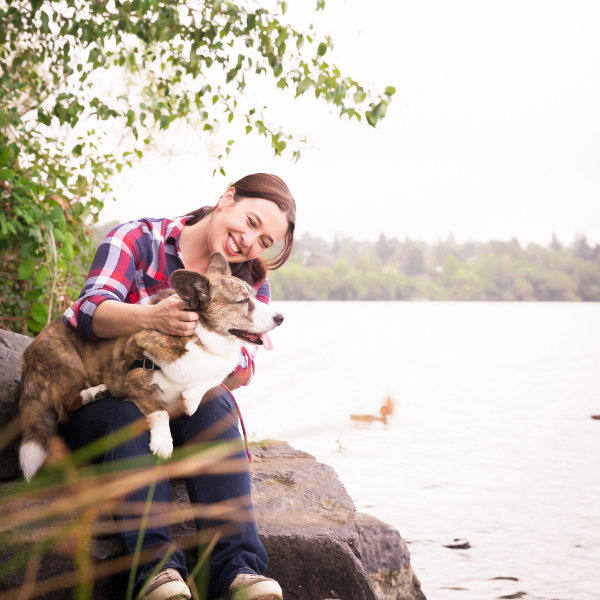
Elizabeth: Yeah. And I’ll link to the article as well and those resources. And the other thing I wanted to add here, too—I know some rescues and shelters rely on a sob story to sell a dog and I just want to point out to people: focus on their personality. Like you said, focus on the good things. And you can include the other characteristics. You don’t have to have a sob story for someone to fall in love with a dog. Me, personally—I want to see their personality. I want to see if it’s a connection. I don’t need to know they had a tragic back story—even though that’s important history sometimes—but you don’t have to fabricate a sob story to help a dog find their perfect forever.
Cathy: You’re right, though. I feel like it does help people—it draws the eyeballs and it’s tugs at the heart strings, and so that’s how adopters—I think we should mention too, on that point if you’re looking to adopt a dog, look at the personality, don’t just look for a sob story. All of those dogs need loving homes. They all deserve loving homes, whether or not they were given up because their owner couldn’t afford to care for them or their owner died. Whatever it was, they all still deserve the love and care of a home. So yeah. I think adopters need to step up, too.
Elizabeth: Yes, absolutely. Yes, there’s no extra bonus points or cookies for adopting a dog with the most tragic backstory. Alright, Cathy, well that I think was all the questions that I had. I think this was really wonderful. Thanks for coming on again. Is there anything else you’d like to add?
Cathy: I think the biggest thing is I just want people, who might be thinking that rehoming
their dog is something they have to do, is reach out for support. And you probably experience this too, but [for] a lot of my clients, I tend to be almost like a therapist for them and it’s one of the most rewarding aspects I think of my job is I get to support these people through really hard things and in, some cases, things that we just can’t fix to the level it needs to be fixed in that home so reaching out for support is so important and finding someone you can talk to about it. Because of that stigma that a lot of people get from other places, they can feel really alone in that decision and they shouldn’t feel alone. So reaching out to your local trainer who you can talk to about it. Talk it through. And I really aim to be as non-judgmental as possible people, because they’re not making that decision lightly. And so reach out for support. And then if you’re just somebody else who’s like, “Oh I hear about people needing to re-home their dogs,” be compassionate, and try to understand what that person’s going through and then if you have the resources and energy to help in any way, oh, it’d be amazing, because those people do need support and help. Even just encouragement and reminding them that they aren’t a failure.
Elizabeth: Yeah and if it’s financial—I mean with my third dog, a visit to the vet for her first visit was $500 and that’s a lot of change but I know you mentioned neighborly and if you know if 10 people offered $20, that’s manageable for everybody, and it’s a way to take the load off. So thinking about creative ways for that financial aspect. Even if you do a little fundraiser where your kid draws photos for people and we can help with ideas for that, too—raising money. There’s lots of creative ways to do that as well if that’s the big—
Cathy: And social media has made it easier as well to create a GoFundMe. Yeah, but I understand people are like, “Well, I don’t want to do that because that’s embarrassing. Yeah, I get it. It’s embarrassing. But I will be embarrassed all day long if it means that I can afford to pay my dog’s bills and keep them with me.
Elizabeth: Yeah. So that’s a little bit of embarrassment or a lifetime of regret. What’s the payoff there. But no, I get it and our society doesn’t make it easy. Well, Cathy, where can the people find you?
Cathy: So they can find me. PreventiveVet.com is our main website. Lots of behavior and training resources as well as health and safety resources. We have a whole team of veterinarians that provide content for us. They’re amazing. But then I also run Pupstanding Academy. So PupstandingAcademy.com offers lots of virtual workshops, and one-on-one private consultations and things like that. So you can find me there.
Elizabeth: Awesome. And I’ll link to all of that as well. And I’m going to go ahead and do the sign off, and then I’ve got one final question for you. This has been Telltail Dog the Podcast with your host, Elizabeth Silverstein, certified dog trainer in central Arkansas, and my guest today, Cathy Madson. Music has been provided by Jim Ciago of Seven Second Chance. Find more of his work on iTunes and Spotify, and stick around after the music for some final advice from Cathy.
[Music]
Elizabeth: Cathy, there’s a lot of shame involved in rehoming. I’m so glad we’re having these conversations. Let’s flip it a little bit. Let’s say you’re someone looking for a dog. Do you have any advice for someone who maybe sees that someone is re-homing for behavior issues?
Cathy: Yeah. So, ask a lot of questions. Be honest with yourself about what are you comfortable handling. Think about what your routine is and if you already have pets. That’s a big thing to really consider. I always really tell people: your current pets have the highest priority in these kinds of decisions, because they didn’t ask for you to bring another dog home, right? And so if bringing that dog home is lowering their quality of life or causing stress for them that’s really something that you need to consider. And I will usually be like, not a good match, right, because I want the established dogs to be respected, so be honest with yourself about what would work in your home. What are your capabilities? What’s your energy, right, for dealing with a behavior issue? Connecting with a certified trainer or behavior consultant, even beforehand, even just to—I do this a lot with clients where I’ll just meet for like a 20-minute session so we can just talk through, would this work or what would a plan look like if I bring this dog home? So, really do your research. Be honest with yourself. And then, reach out for support. It’s a big thing. It’s the theme today.
Profile To Use for Rehoming (Remember to include photos!)
Dog’s name:
Age:
Birthdate, if known:
Breed, if known:
Markings and colors:
Has your dog done any training? What training do they know? What cues and hand signals?
Are they crate trained?
What are their favorite toys, things to do, and food?
What type of dog food do they eat? How much do they eat and how many times a day?
Has the dog been on a schedule at all? What activities do they like to do daily? Weekly? Monthly?
Have they been to doggy daycare? Where? Have there been any reported incidents at doggy daycare?
Do they have any dog friends, or do they like cats or any other animals?
What is their personality like? (Things to consider include: Do they like to cuddle? Follow you everywhere? Spend time alone? Are they serious? Are they a goof?)
What are some of the challenges? (Things to consider include: Do they struggle with new things, new people, walking on a leash, barking, digging, separation anxiety or anything else?)
Have they ever nipped anyone?
From what you know, what type of home would this dog do best in? (Things to consider include: No children, only children over the age of 12, a peaceful, retirement home, an active home, an active home where they can spend a lot of time with the dog)

